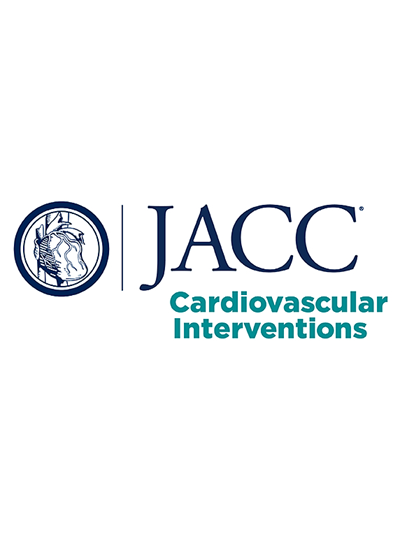血液透析患者股腘药物包被球囊治疗后血管通畅
IF 11.7
1区 医学
Q1 CARDIAC & CARDIOVASCULAR SYSTEMS
引用次数: 0
摘要
药物包覆球囊(DCBs)被广泛用作股腘动脉病变的核心治疗方法,但尚未有大规模的前瞻性研究评估DCB在血液透析(HD)患者中的应用。目的:作者试图澄清HD患者症状性股腘动脉疾病DCB治疗后再狭窄的风险及相关因素。方法我们分析了一项多中心前瞻性研究的数据库,该研究登记了接受DCB治疗(Lutonix或IN)的患者。从2018年3月到2019年12月。在3165个登记的病变中,991个病变发生在HD患者身上。主要结局是无再狭窄。结果HD组更年轻(72±9岁vs 76±9岁),糖尿病发生率更高(76.5%[557/728例]vs 60.8%[1081 / 1779例])。慢性肢体威胁性缺血患病率为52.2%(444/850例)vs 22.1%(437/ 1977例)。Lutonix用于30.6%(688/991个病变)对21.3%(462/ 2174个病变)和in。PACT Admiral用于69.4%(303/991个病灶)vs 78.7%(1712 / 2174个病灶)。在倾向评分匹配后,1年和3年HD组和非HD组的再狭窄自由率分别为82.2% (95% CI: 79.0%-85.3%)和85.8%(83.0%-88.7%),3年分别为61.9%(57.7%-66.1%)和66.3%(62.2%-70.4%)。在HD组中位随访时间为16.2个月(Q1-Q3: 7.2-35.5个月),363个病灶发生再狭窄。与HD组再狭窄风险独立相关的因素有膝下无血流、血管内治疗史、腘窝病变、严重钙化、使用Lutonix和严重夹层。结论sdcb血管内治疗是治疗HD患者股腘动脉病变的合理方法。本文章由计算机程序翻译,如有差异,请以英文原文为准。
Vessel Patency After Femoropopliteal Drug-Coated Balloon Therapy in Patients on Hemodialysis
Background
Drug-coated balloons (DCBs) are widely used as a core treatment for femoropopliteal lesions, but no largescale prospective studies have evaluated DCB in hemodialysis (HD) patients.
Objectives
The authors sought to clarify restenosis risk and associated factors after DCB therapy for symptomatic femoropopliteal artery disease in patients on HD.
Methods
We analyzed the database of a multicenter prospective study that registered patients undergoing DCB treatment (either Lutonix or IN.PACT Admiral) from March 2018 to December 2019. Of the 3,165 registered lesions, 991 lesions were in patients on HD. The primary outcome was freedom from restenosis.
Results
The HD group was younger (72 ± 9 years vs 76 ± 9 years) and had a higher frequency of diabetes (76.5% [557/728 patients]) vs 60.8% [1,081/1,779 patients]). The prevalence of chronic limb-threatening ischemia was 52.2% (444/850 patients) vs 22.1% (437/1,977 patients). Lutonix was used in 30.6% (688/991 lesions) vs 21.3% (462/2,174 lesions), and IN.PACT Admiral was used in 69.4% (303/991 lesions) vs 78.7% (1,712/2,174 lesions). After propensity-score matching, the 1- and 3-year rates of freedom from restenosis in the HD and non-HD groups were 82.2% (95% CI: 79.0%-85.3%) vs 85.8% (83.0%-88.7%) at 1 year and 61.9% (57.7%-66.1%) vs 66.3% (62.2%-70.4%) at 3 years, respectively. In the HD group, restenosis occurred in 363 lesions during a median follow-up of 16.2 months (Q1-Q3: 7.2-35.5 months). Factors independently associated with restenosis risk in the HD group were no below-the-knee runoff, history of endovascular therapy, popliteal lesion, severe calcification, use of Lutonix, and severe dissection.
Conclusions
DCB endovascular therapy is a reasonable treatment for femoropopliteal lesions in patients on HD.
求助全文
通过发布文献求助,成功后即可免费获取论文全文。
去求助
来源期刊

JACC. Cardiovascular interventions
CARDIAC & CARDIOVASCULAR SYSTEMS-
CiteScore
11.60
自引率
8.80%
发文量
756
审稿时长
4-8 weeks
期刊介绍:
JACC: Cardiovascular Interventions is a specialist journal launched by the Journal of the American College of Cardiology (JACC). It covers the entire field of interventional cardiovascular medicine, including cardiac, peripheral, and cerebrovascular interventions. The journal publishes studies that will impact the practice of interventional cardiovascular medicine, including clinical trials, experimental studies, and in-depth discussions by respected experts. To enhance visual understanding, the journal is published both in print and electronically, utilizing the latest technologies.
 求助内容:
求助内容: 应助结果提醒方式:
应助结果提醒方式:


